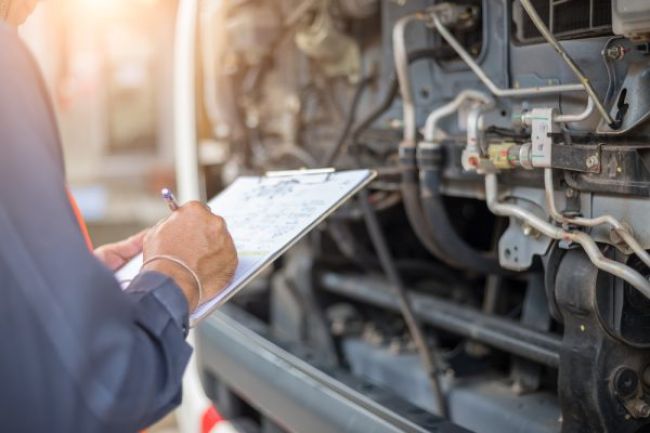
How Fleet Maintenance Can Advance Driver Safety
Along with controlling the wide range of equipment costs that come with running a fleet, plus the need to maximize vehicle utilization and drivers’ time behind the wheel, every fleet maintenance program should be geared toward improving safety – to reduce operating costs and, above all, to decrease the risk exposure for fleet drivers and the motoring public.
Even a minor maintenance issue that is deferred or, worse, never noted on an inspection can snowball risk to your drivers and other motorists if left unresolved. Maintenance and safety clearly dovetail in the inspection and care given to a range of systems, starting with brakes, lights, tires, and wheels and axles, as well as electrical system components and any instances of physical damage.
“Committing to a consistent preventive maintenance schedule for all of your fleet’s equipment – tractors and trailers alike – not only maximizes uptime, but can help boost longevity, resale value, and even safety,” contends a blog post written by Carlos Mendiola, group director, finance, for Ryder’s Fleet Maintenance Solutions business unit.
Mendiola lays out PM tips in the post, including two that pack a solid safety punch: leveraging DVIR data and VMRS codes. “The DVIR is your canary in the coal mine,” he said. “Regularly review driver vehicle inspection reports or DVIRs and take action to fix things they note as being out of spec. If drivers see that you are taking their findings seriously, they are more likely to become diligent in their pre- and post-trip inspections. DVIRs also note issues that can lead to tractor-trailers failing roadside inspections too.”
Tapping the Codes
As for the vehicle maintenance reporting standards (VMRS), these codes were developed in 1970 by the American Trucking Associations’ Technology and Maintenance Council to provide a single, concise coding convention for managing fleet assets and analyzing maintenance costs.
“VMRS codes are the ‘universal language’ of the truck and trailer maintenance and repair business,” Mendiola explained. “They define exactly what is wrong with a truck and what was done to repair it.” He said these codes become especially important if outside service providers are used for PM services as “they keep everyone on the same page.”
According to a blog post from Rand McNally, “A fleet safety program isn’t solely about monitoring your drivers. Knowing how to improve your fleet safety program also includes vehicle inspection and maintenance. Regular maintenance helps reduce the costs of unexpected breakdowns and helps prevent accidents caused by damaged parts.”
Each driver should follow an inspection procedure to ensure safe operating conditions, the company recommended. “Regular inspections that are documented and assessed to see if further maintenance is necessary help with early detection of defects or vehicle issues.” Neglecting regular maintenance and inspections can raise repair costs, put drivers at greater risk, and increase the likelihood of violations and fines.
Maintenance and inspections should be scheduled. Rand McNally suggests including oil and filter changes; inspections of belts, brakes, radiators and other critical components; and rotating tires. “Engines, transmissions, and drivetrains require more major work that should be performed when needed.”
Training and Education
Both maintenance managers and drivers should receive safety training. This training can be conducted in phases. For example, Rand McNally advises training your supervisors and core team first. Then they can train other staffers and the drivers. “Mandatory training programs help everyone understand safety policies and procedures. You can also hold regular meetings to discuss company rules, regulations, defensive and backing techniques, adverse weather, maintenance, accident reporting, emergency procedures, and other topics.”
One-on-one training is more hands-on, which is especially helpful when corrective actions need to be taken by a driver. According to Rand McNally, “It’s important to have a predetermined safety threshold and appropriate one-on-one conversations with those who drop below it. Conduct regular coaching sessions in groups and personalized sessions for drivers who go below the safety threshold. Have a standardized script for these instances to eliminate biases.”
Safety Guidance
According to guidance about how maintenance can positively impact safety published by the Federal Motor Carrier Safety Administration, drivers should know how to properly maintain trucks – for their safety and the safety of others. “Employers should ensure that their drivers know that any vehicle malfunction, maintenance problem, or load securement issue must be addressed proactively to prevent crashes,” the agency stated.
Fleets should also “educate drivers about how to properly conduct pre- and post-trip inspections, record vehicle defects on DVIRs, and ensure that any defects which would hinder safe operation of the vehicle are repaired prior to operating the vehicle,” according to the FMCSA. In addition, fleets should train drivers on how to properly load commercial vehicles to prevent shifting of loads, spilling or dropping cargo, and overloading. Drivers’ questions about their role in maintenance efforts to boost safety should be answered, or “direct them to the information they need, including FMCSA’s websites.”
Consider this 360-degree view of safety, courtesy of a statistic from the Harvard Business Review: “Improving employee engagement is not simply about improving productivity … Specifically, high-turnover organizations report 25% lower turnover, and low-turnover organizations report 65% lower turnover. Engagement also improves quality of work and health … higher scoring business units report 48% fewer safety incidents.”
In short, engage your drivers with your maintenance and equipment experts as you train them and track, report and advance their safety performance – on the road and at the job site.
About the Author: David Cullen is an award-winning journalist who specializes in covering the trucking industry. Based in Connecticut, he writes for several business publications.

